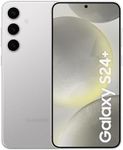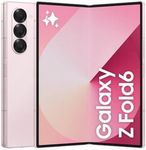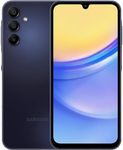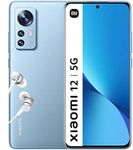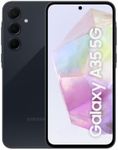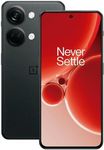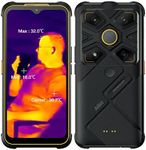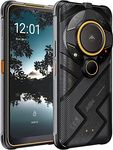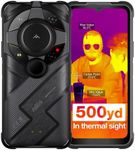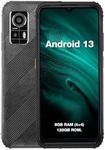Buying Guide for the Best Large Screen Smartphones
Choosing the right large-screen smartphone can be a daunting task, but with the right approach, you can find a device that perfectly suits your needs. Large-screen smartphones, often referred to as phablets, offer a great balance between the functionality of a tablet and the portability of a phone. When selecting a large-screen smartphone, it's important to consider several key specifications to ensure you get the best fit for your lifestyle and usage patterns.Screen SizeScreen size is the diagonal measurement of the display, usually measured in inches. This spec is crucial because it determines how much screen real estate you have for viewing content, playing games, and multitasking. Large-screen smartphones typically range from 6.5 inches to over 7 inches. If you enjoy watching videos, gaming, or need more space for productivity tasks, a larger screen (closer to 7 inches) might be ideal. However, if you prefer a more manageable size that still offers ample viewing area, a screen size around 6.5 to 6.8 inches could be a better fit.
Display ResolutionDisplay resolution refers to the number of pixels on the screen, usually denoted as Full HD (1080p), Quad HD (1440p), or 4K (2160p). This spec is important because it affects the clarity and sharpness of the display. Higher resolutions provide crisper and more detailed images. For most users, a Full HD resolution is sufficient and offers a good balance between quality and battery life. However, if you are a media enthusiast or use your phone for professional purposes like photo editing, a Quad HD or 4K display might be worth considering for the extra detail and sharpness.
Battery LifeBattery life is determined by the battery capacity, measured in milliampere-hours (mAh), and how efficiently the phone uses power. This spec is crucial for ensuring your phone lasts through the day, especially with the larger screens that consume more power. Large-screen smartphones typically have batteries ranging from 4000mAh to 6000mAh. If you are a heavy user who spends a lot of time on your phone for gaming, streaming, or work, look for a battery capacity of at least 5000mAh. For moderate users, a battery around 4000mAh to 4500mAh should be sufficient.
ProcessorThe processor, or CPU, is the brain of the smartphone, determining how fast and efficiently it can run apps and perform tasks. This spec is important for overall performance, especially for multitasking and running demanding applications. Processors are often categorized by their number of cores and clock speed (measured in GHz). High-end processors with more cores and higher clock speeds are ideal for power users who need top performance for gaming, video editing, or other intensive tasks. For everyday use, a mid-range processor should provide a smooth experience for browsing, social media, and casual gaming.
Camera QualityCamera quality is determined by several factors, including the number of megapixels (MP), aperture size, and additional features like optical image stabilization (OIS) and multiple lenses. This spec is important if you frequently take photos or videos. Higher megapixels can provide more detail, but other factors like sensor size and software optimization also play a significant role. If photography is a priority, look for a smartphone with a high MP count, good low-light performance (indicated by a lower aperture number), and additional features like OIS. For casual photography, a mid-range camera setup should suffice.
Storage CapacityStorage capacity refers to the amount of internal space available for apps, photos, videos, and other data, measured in gigabytes (GB). This spec is important to ensure you have enough space for your needs without constantly managing storage. Large-screen smartphones often come with storage options ranging from 64GB to 512GB. If you store a lot of media files or use many apps, consider a higher storage capacity (256GB or more). For lighter use, such as basic apps and occasional photos, 64GB to 128GB should be adequate. Additionally, check if the phone supports expandable storage via microSD cards.
RAMRAM (Random Access Memory) is the memory used by the smartphone to run apps and multitask. This spec is important for ensuring smooth performance, especially when switching between multiple apps. Large-screen smartphones typically come with RAM ranging from 4GB to 12GB. For basic tasks and light multitasking, 4GB to 6GB of RAM should be sufficient. If you are a power user who frequently multitasks or uses resource-intensive apps, consider a phone with 8GB or more RAM to ensure a seamless experience.
Build Quality and DesignBuild quality and design refer to the materials and construction of the smartphone, as well as its overall aesthetic. This spec is important for durability and user experience. Large-screen smartphones can be made from various materials, including plastic, metal, and glass. If you prioritize durability, look for phones with metal or reinforced glass bodies. Additionally, consider the phone's weight and ergonomics, as larger screens can make devices heavier and harder to handle. Choose a design that feels comfortable in your hand and suits your style preferences.
Operating System and SoftwareThe operating system (OS) and software determine the user interface and available features of the smartphone. This spec is important for ensuring compatibility with your preferred apps and services. Large-screen smartphones typically run on Android or iOS. If you prefer a highly customizable experience with a wide range of device options, Android might be the best choice. If you value a seamless ecosystem with other Apple products and a user-friendly interface, iOS could be more suitable. Consider the software features and updates offered by each OS to find the best fit for your needs.


